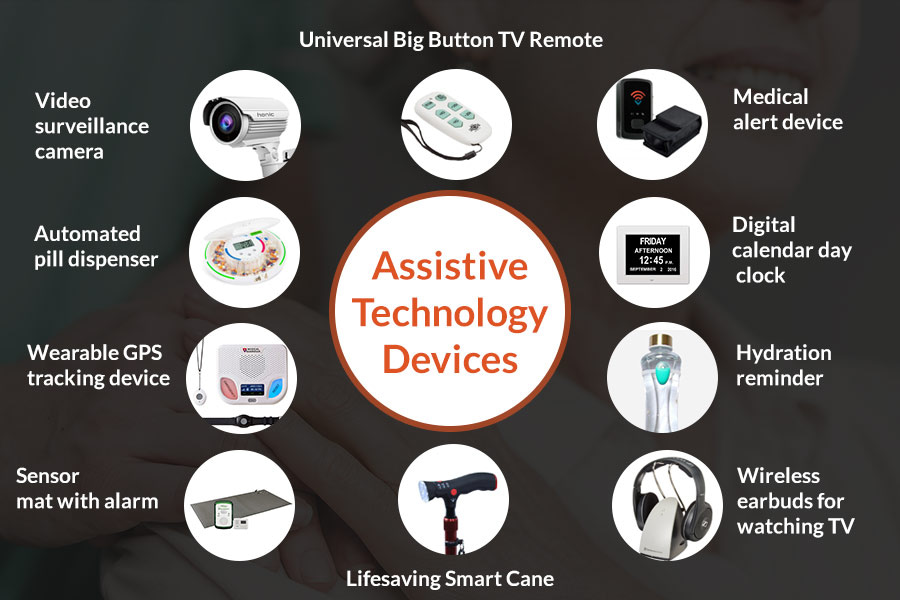Understanding the Concept of Assistive Technology
Assistive technology, as defined by the Assistive Technology Industry Association (ATIA), encompasses any device, system, or design that improves the functional capacities of individuals with disabilities. It empowers those with physical or cognitive challenges to live independently, safely, and confidently.
A Brief History and Evolution of Assistive Technologies
The concept of assistive technology has evolved significantly over time. What started as simple implements like canes and hearing aids has now expanded into high-tech devices like voice recognition software and wearable sensors. According to the National Center for Biotechnology Information (NCBI), this evolution has paved the way for more innovative and personalized solutions for the aging population.
Image: A timeline illustrating the evolution of assistive technologies, from simple tools to high-tech devices.
The Importance of Assistive Technologies for the Aging Population
Assistive technologies play a crucial role in enhancing the quality of life and maintaining the independence of the aging population. These technologies, as reported by World Health Organization (WHO), can aid in daily activities, manage health conditions, and even promote social interaction, thereby fostering a sense of self-sufficiency and well-being among seniors.
The Current State of Assistive Technologies for the Aging
As our society ages, the need for efficient and effective assistive technologies grows. These tools, ranging from simple wearable devices to complex home automation systems, are designed to enhance the quality of life for the elderly, promoting independence and safety.

The impact of these technologies is substantial. They not only alleviate common age-related issues – such as mobility difficulties and memory loss – but also provide emotional support, reducing feelings of isolation and promoting mental wellness. However, it’s not all smooth sailing. Current assistive technologies face challenges, including high costs, accessibility issues, and a steep learning curve for the technologically unacquainted. Moreover, there are concerns surrounding privacy and the ethical use of data collected by these devices.

The Potential Benefits of Assistive Technologies for the Aging Population
Despite these obstacles, the potential benefits of assistive technologies for the aging population are too significant to ignore. With continued research, development, and ethical considerations, these tools can be optimized to better serve our elderly population.
The Impact of Technological Advances on Assistive Technologies
Artificial Intelligence (AI), Machine Learning (ML), and Robotics are rapidly transforming various industries, including assistive technology for the aging. These advances hold immense potential to revolutionize this landscape, providing improved solutions for the elderly.
Revolutionizing Assistive Technology for the Aging
AI and ML are pivotal in developing smarter, more intuitive, and responsive assistive devices. These technologies enable devices to learn from user behavior, adapt to their needs, and offer personalized assistance. For instance, AI-powered hearing aids can filter out background noise, focusing on human speech, enhancing the user’s auditory experience.
Robotics, on the other hand, can assist in mobility, daily tasks, and even provide companionship. For example, robotic exoskeletons can aid in walking, while robotic companions can interact with the elderly, reducing feelings of loneliness.

Anticipated Developments in Assistive Technologies for the Aging
In the rapidly advancing field of assistive technologies, we can expect several transformative innovations catering specifically to the aging population. Emerging technologies such as advanced robotics, AI-driven health monitoring systems, and the Internet of Things (IoT) are likely to define the future landscape of elderly care. These advancements are predicted to not only enhance the quality of life for seniors but also provide vital support in managing chronic conditions and maintaining independence.

The Impact of These Trends on Elderly Health and Lifestyle
These anticipated trends in assistive technologies hold immense potential to reshape the health and lifestyle of the elderly. Improved remote health monitoring systems can aid in timely detection and management of health issues, reducing the need for hospital visits. IoT-enabled smart homes can provide a safer and more comfortable living environment, while advanced robotics may assist in daily tasks, promoting self-reliance. These technologies are not only a response to the health and lifestyle needs of seniors; they are an investment in their autonomy and dignity.
Case Studies of Innovative Future Assistive Technologies
As we venture further into the 21st century, technology continues to evolve at an unprecedented pace. This rapid development is reshaping numerous industries, including the field of assistive technology designed to aid our aging population. Assistive technologies are increasingly seen as a solution to many challenges that the elderly face.
In an intriguing study by the National Institutes of Health, several future assistive technologies have been identified that hold immense potential. For instance, ‘Smart Homes’ are currently under development that can monitor the wellbeing of seniors, alerting healthcare providers in case of emergencies. Additionally, wearable devices are being designed to track vital signs, and robotic aids are being developed to assist with mobility and daily tasks.

Addressing Specific Needs of the Aging Population
These innovative technologies are specifically designed to cater to the unique needs of the elderly. They are focused on enhancing the quality of life, promoting independence, and ensuring safety. For example, the aforementioned Smart Homes can address the issue of social isolation – a common problem faced by the elderly – by facilitating virtual social interactions.
Similarly, wearable devices can monitor health metrics, thereby facilitating timely medical interventions. Robotic aids can help the elderly perform tasks that they may find challenging, reducing the risk of injury. These technologies represent the future of assistive care, promising a safer, more independent life for our aging population. More research and case studies are needed to further refine and personalize these technologies.
The Role of Policy and Regulation in Shaping Assistive Technologies
Within the realm of assistive technologies, the current regulatory environment plays a crucial role in defining the trajectory of innovation. Regulations can either catalyze or inhibit the development of new technologies, depending on whether they encourage research and development or impose overly restrictive barriers.
For future assistive technologies to truly serve aging populations, policy makers must consider the specific needs and perspectives of this demographic. According to the Administration for Community Living, an aging population presents unique challenges and opportunities in the field of assistive technologies.

Policy and regulation have the potential to shape a future where assistive technologies are accessible, affordable, and tailored to the needs of the aging population. Therefore, it is essential that these considerations be incorporated into policy discussions and regulatory decisions.
Challenges and Opportunities in the Future of Assistive Technologies
The development and implementation of future assistive technologies face potential obstacles such as high development costs, technological complexity, and user acceptance. These challenges, though daunting, present significant opportunities for entrepreneurs, researchers, and policymakers.
An initial challenge is the high cost of research, development, and production. However, this also opens up opportunities for funding and partnerships. By exploring new financial models, such as public-private partnerships or crowdfunding, entrepreneurs can overcome these financial hurdles.
Another challenge is the technological complexity and the integration of these technologies into existing systems. Yet, for researchers, this complexity is a catalyst for innovation. It pushes for the development of more user-friendly, efficient, and effective technologies.
The last challenge is user acceptance. To ensure that the aging population accepts and uses these technologies, they must be user-friendly and meet their specific needs. This presents a unique opportunity for policymakers to enact legislation that encourages the development of user-centered technologies. Research suggests that when technology is designed with the end-user in mind, it is more likely to be accepted and used effectively.
Concluding Thoughts on the Future of Assistive Technologies for the Aging

In our exploration of the future of assistive technologies for aging, we’ve unearthed some critical points. The rapid advancements in this field are poised to revolutionize senior care and independent living. From wearable tech and mobile apps to AI-powered home systems and robotics, the scope for innovation is expansive and promising.
The crux of the matter is the importance of ongoing research and development. The National Institute on Aging and other similar institutions are spearheading efforts to enhance the quality of life for older adults through technology. However, the continuous evolution of these technologies is crucial to keep up with the growing demands of an aging population.
The Potential of Assistive Technologies
In conclusion, the potential of assistive technologies to enhance the lives of the aging population is immense. They can transform the way we approach senior care, making it more personalized, efficient, and dignified. The future is undoubtedly exciting, and it’s up to us to harness the power of these innovations to create a world where aging can be embraced with grace and independence.





